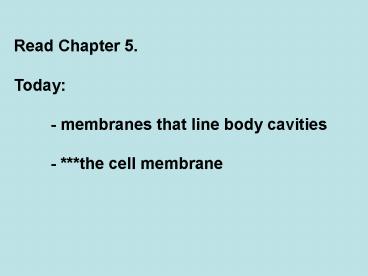Read Chapter 5' - PowerPoint PPT Presentation
Title:
Read Chapter 5'
Description:
Why have a cell membrane? - isolate the cell cytosol (intracellular fluid) from ... structural support cellular junctions, anchor cytoskeletal proteins ... – PowerPoint PPT presentation
Number of Views:42
Avg rating:3.0/5.0
Title: Read Chapter 5'
1
Read Chapter 5. Today - membranes that line
body cavities - the cell membrane
2
Membranes in the body line a body cavity or are
between two compartments.
3
Why have a cell membrane? - isolate the cell ?
cytosol (intracellular fluid) from extracellular
fluid - regulate exchange with the environment
? ions, nutrients, wastes, secretions - cell
communicates with the environment ? eg. receptor
proteins bind signaling molecules - structural
support ? cellular junctions, anchor cytoskeletal
proteins
4
What are the components of the cell membrane and
what are their functions?
5
What are the components of the cell membrane and
what are their functions?
6
Lots of phospholipids.
7
(No Transcript)
8
(No Transcript)
9
(No Transcript)
10
Integral mb proteins are tightly associated to mb
(eg. membrane spanning). Associated protein
is loosely bound to mb (eg. enzymes, some
structural).
11
An example of a membrane spanning protein.
12
Functions of membrane proteins 1. Structural
proteins (junctions, cytoskeleton) 3. Receptors
bind a signaling molecule (ligand) 2. Enzymes
reactions cell membrane (digestion,
signaling) 4. Transporters - channels - water
filled pore - carrier proteins - bind molecule
to be carried across
13
1. Structural proteinsjunctions
Functions of membrane proteins
14
1. Structural proteins cytoskeleton
Functions of membrane proteins
15
2. Cell membrane receptor protein
3. Enzymes
Functions of membrane proteins
16
3. Channel proteins are gated.
17
Gating of a channel protein
18
How are the channels gated (opened)?Voltage
gated, chemically gated, mechanically gated.
19
4. Facilitated diffusion by a carrier protein
- never a continuous pore
20
Facilitated diffusion by a carrier protein
21
How can lipids enter a cell?
22
(No Transcript)
23
How can glucose enter a cell?
24
Facilitated diffusion by a carrier protein
G
G
G
25
How can calcium (Ca) enter a cell?
26
Calcium enters through a calcium channel
Ca
27
How does insulin bind onto a cell?
28
Insulin receptor protein
Insulin
Insulin































